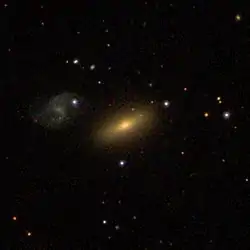NGC 42
NGC 42 is a lenticular galaxy[5] in the Pegasus constellation. It was discovered on Oct 30, 1864 by the astronomer Albert Marth. It may be gravitationally interacting with the nearby NGC 41.[6]
| NGC 42 | |
|---|---|
 SDSS image of NGC 42 | |
| Observation data (J2000 epoch) | |
| Constellation | Pegasus |
| Right ascension | 00h 12m 56.361s[1] |
| Declination | +22° 06′ 01.00″[1] |
| Redshift | 0.019927[2] |
| Helio radial velocity | 5914 km/s[2] |
| Distance | 263.2 Mly (80.70 Mpc)[3] |
| Apparent magnitude (B) | 15.07[4] |
| Characteristics | |
| Type | S0−:[5] |
| Other designations | |
| UGC 118, MCG+04-01-041, PGC 867[2] | |
References
- Skrutskie, M. (2006). "The Two Micron All Sky Survey (2MASS)". The Astronomical Journal. 131 (2): 1163–1183. Bibcode:2006AJ....131.1163S. doi:10.1086/498708.
- "NGC 42". SIMBAD. Centre de données astronomiques de Strasbourg. Retrieved 2021-02-04.
- Crook, Aidan C.; Huchra, John P.; Martimbeau, Nathalie; Masters, Karen L.; Jarrett, Tom; Macri, Lucas M. (2007). "Groups of Galaxies in the Two Micron All Sky Redshift Survey". The Astrophysical Journal. 655 (2): 790–813. arXiv:astro-ph/0610732. Bibcode:2007ApJ...655..790C. doi:10.1086/510201.
- "Search specification: NGC 42". HyperLeda. Université Claude Bernard Lyon 1. Retrieved 2021-02-04.
- "Results for object NGC 0042 (NGC 42)". NASA/IPAC Extragalactic Database. California Institute of Technology. Retrieved 2021-02-04.
- Seligman, Courtney. "New General Catalogue objects: NGC 1 - 49". cseligman.com. Retrieved 2021-02-04.
This article is issued from Wikipedia. The text is licensed under Creative Commons - Attribution - Sharealike. Additional terms may apply for the media files.